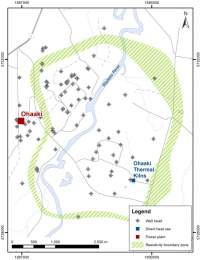Ohaaki Geothermal System
Location and general description

The Ohaaki-Broadlands Geothermal System is located within the Waikato Region, 20 km northeast of Taupo, immediately south of State Highway 5. The field covers an area of about 5 to 11 km2.
The Waikato Regional Plan classifies the Ohaaki-Broadlands Geothermal System as a Development Geothermal System where the take, use and discharge of geothermal energy and water will be allowed, while:
- remedying or mitigating significant adverse effects on Significant Geothermal Features; and
- avoiding, remedying or mitigating adverse effects on other natural and physical resources including overlying structures (the built environment).
This classification is based on:
- The system is already subject to large scale energy use and development.
- Existing surface features significantly impaired by legally established large takes.
- No evidence of a flow of subsurface geothermal fluid to or from a Protected Geothermal System.
Local Geology and geophysics, wells drilled, etc.
In 2010 there were 23 production wells, which extracted around 1,500 t/hr of fluid from a depth of 1,000 to 2,500m from the Ohaaki area of the field. There are six reinjection wells.
The major stratigraphic units comprise the following:
- Huka Falls Formation: a mudstone that acts as a cap over much of the field.
- Ohaaki Rhyolite: this lava has high horizontal permeability and is hydraulically connected to groundwater aquifers.
- Waiora Formation: the main producing aquifer composed of heterogeneous uncompacted pumice and lapilli tuffs. Lying immediately below the Ohaaki Rhyolite or separated by a thin Huka Falls mudstone layer, it appears to be hydrologically connected to the overlying Ohaaki Rhyolite.
- Rautawiri Breccia: the second important aquifer composed of coarse breccias.
- Rangitaiki Ignimbrite, Ohakuri Group volcanics and Waiora Formation conglomerates: rocks of poorly known production material
- Greywacke: permeability will exist in fractures.
Natural features
Significant Geothermal Feature types present include:
- Culturally significant feature (Ohaaki Ngawha)
- Heated ground habitat
- Recent sinter (Ohaaki Ngawha)
At Waikato River Springs
- Geothermally-influenced aquatic habitat
- Geothermally-induced atmospheric microclimate
- Geothermally-influenced water body (pools)
Geothermal vegetation
The western steamfield geothermal area is of regional significance because it is a relatively large example geothermal vegetation, which includes nationally uncommon ecosystem types such as geothermally heated dry ground, fumaroles. The site also contains a large population of an ‘At Risk’ plant species (prostrate kānuka), and a small population of Dicranopteris linearis, another ‘At Risk’ plant species.
Ohaaki Steamfield East is of regional significance because it is partially protected by a QEII National Trust covenant and is a relatively large example of geothermal habitat, which includes the nationally uncommon ecosystem type, geothermally heated dry ground. The site also contains a good population geothermal kānuka.
Existing and historical geothermal uses
The Ohaaki power station, with its conspicuous 105m high cooling tower, was commissioned in 1989 and is owned by Contact Energy.
The station commenced with a capacity of 114 MW(e) although declining steam production has led to a series of deratings – including decommissioning of one of their high-pressure turbines. (When designed, the HP turbines were expected to have a ten-year service life, before the field pressures would have dropped so that the HP system would be retired). Steam production has further declined due to cool water from the field margins encroaching on production wells. Output dropped to as low as 30 MWe but an investment programme, including several new wells, has restored production to about 50 MWe (450 GWh/year).
There have been significant environmental effects at Ohaaki, including subsidence leading to flooding.
60% of produced fluid is injected, mostly through outfield injection. Much of the balance of fluid is lost through the cooling tower and about 4-5% is fed to a wood drying kiln operation. This then discharges fluid to a previously active surface feature and subsequently the Waikato River.
There have been lucerne drying operations and geothermally heated greenhouses at Ohaaki in the past.
Inferred size of resource
Based on stored heat models, the energy development potential is about 110 MW(e).



